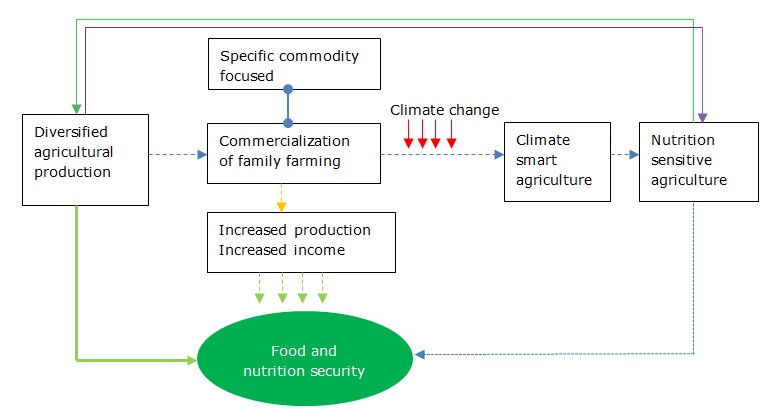-
About
- Our Work
- Get Involved
- Stay Updated
Positive retrogression: Why small-holder farming is heading back to diversification?
It’s a common fact that family and small-holder farming contributes to food security, income generation, and employment for a majority of people in developing countries. The International Fund for Agricultural Development (IFAD) 2013 estimates that small-holders produce about 80% of food consumed in developing countries. The United Nations’ declaration making 2014 the year of as the family farming recognizes this fact. The potential in these family farming systems is not in question. However, finding contextualised sustainable solutions for small-holder farming, often in developing countries, is a challenge and will occupy discussions by donors and development agencies for some time.
So why has it been difficult to understand and find lasting solutions for these farmers? Small-holder farming in developing countries is a complex system despite a belief in the contrary as economics, cultural, gender, and technological issues come into play. To understand the dynamics of the system, we may want to ask ourselves (i) What do small-holder farmers really need? (ii) What do the donors and development agencies think farmers need? (iii) What are we missing? Keep these questions in mind as we go through the evolution of family farming.
The beginning: diversified production
Initially, farmers practiced small but diversified production systems as a risk reduction strategy and to ensure food security. This practice was more subsistence oriented as the main focus was to be able to feed one’s family. The diversified production meant little or no specialization in a particular commodity.
To address this “challenge”, governments, donors, and development agencies then promoted commercialization of family farms targeting specific commodities. This was seen as a chance for these farmers to improve their productivity and increase their incomes. The assumption made was that with more money, farmers would buy the food they needed and, therefore, still be food secure. That assumption is wrong in most cases.
 Heading to a wicked food situation?
Heading to a wicked food situation?The benefit of commercializing family farms is that emphasis is on target commodities and, therefore, farmers become specialized producers. The flip side of the coin is not so rosy as most of the commodities produced often receive less attention or are totally neglected. This is what Antony Chapoto (2013) describes in his paper “Food Security in the Pocket or Food First? Synergies and trade offs of cash cropping on Food Security”.
The important but complex interdependency between diversified production, food, and nutrition security (as often small-holder farmers eat what they produce) was overlooked in the push. Experience has shown that there is no guarantee that farmers will buy the food they need (if they manage to get enough income from agricultural production) to be food and nutritionally secure. It seems we are headed to a wicked situation.
Meanwhile, climate change pressure demands that we infuse adaptive measures in our agricultural production process. And small-holder farms receive a multitude of sometimes differing messages from all the players and the issues involved.
Look from a farmers’ perspective
Acknowledgement of nutrition security in family farming has been highlighted in many forums and this will also form part of the considerations in co-designing small-holder farming systems. So we have passed through different stages in trying to solve the family farming challenges and learning through it all.
The response at each level only confirms the dynamic nature of this system, prompting equally versatile solutions. We may think we know what is best for the farmers but it too often backfires.
To design a truly responsive small-holder farming system formulated around food and nutrition security, as well as address climate issues, we have to look at everything from a farmers’ perspective. Already most agricultural projects are recognising the need to have farmers diversify their operations to boost food and nutrition security. This development has also seen a return in the production of many traditional crops (orphaned crops) because of their high nutritional value and adaptive capacity to harsh weather.
Is this not where the farmers were in the beginning?
Their reasons or motivations for where they started could be different, but science proves that their methods were effective based on their individual situations. It is clear we are going back to where we started from, but this time with the advantage of better knowledge and tried-and-true experience.
Picture credit: Thomas Kitinya Kirina
About the author
Related Posts
Comments
No comments made yet. Be the first to submit a commentBy accepting you will be accessing a service provided by a third-party external to https://www.ypard.net/
Get in touch
Email: [email protected]
YPARD Global Coordination UnitHosted by AGRIDEA and the Czech University of Life Sciences Prague
Lausanne, Switzerland and Prague, Czech Republic - Our Work

 Heading to a wicked food situation?
Heading to a wicked food situation?